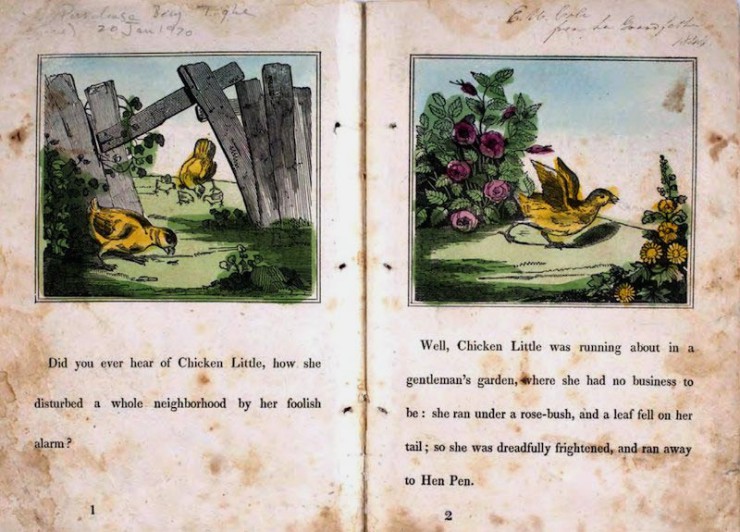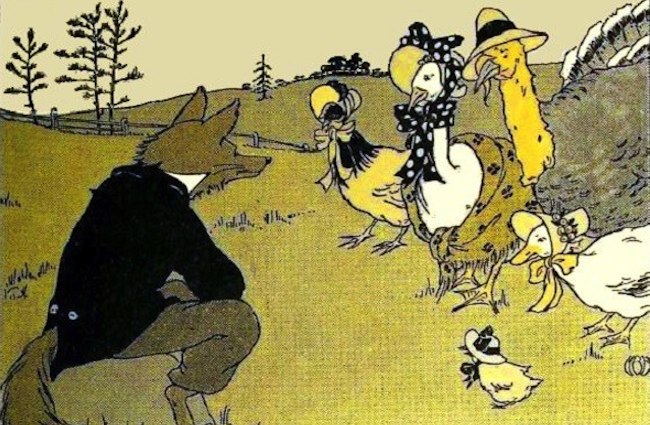The story of Henny Penny, also called Chicken Little, or sometimes Chicken-licken (not to be confused with “Finger-licken” from Kentucky Fried Chicken), the terrified little chicken convinced that the sky is falling and that life as we, or at least as chickens know it, is over, is common throughout European folklore—so common that “the sky is falling!” and “Chicken Little” and related names have become bywords for fearmongering, and the often tragic results that occur.
Exactly where the first version of the story was told is a bit unclear, but one of the first to record the tale was Just Mathias Thiele (1795–1874), a Danish scholar employed at the Royal Danish Library. Inspired by Jacob and William Grimm, he began collecting Danish folktales, publishing his first collection in 1818. The collections proved to be so influential that Hans Christian Anderson would later dedicate a story to Thiele’s daughter. His version of Henny Penny appeared in his 1823 collection, with the familiar elements already present: rhyming names, a series of barn animals, a terror set off by something completely ordinary (in this case, a falling nut) and a very hungry fox more than willing to take advantage of the situation.
That version was not, however, translated into English until 1853. Before that, young American readers had access only to a slightly different version written and published by John Green Chandler. Trained as a wood engraver, he eventually became a lithographer and illustrator who ended up specializing in simple and elaborate paper dolls. In 1839, he set up a small printing business in Roxbury, Massachusetts. Possibly to help advertise his new business (my speculation), or possibly to help raise funds for Boston’s Bunker Hill Monument (slightly more historical speculation) or both, in 1840 his press printed a small pamphlet, The Remarkable Story of Chicken Little, featuring his texts and illustrations, available for a few cents. More recently, an internet auction sold a rare original copy for $650.
Chandler’s version is delightfully simple, if not always that grammatically correct—the story arbitrarily switches between past and present tense, for instance, sometimes in the same sentence. And I am more than a little concerned that what Chandler originally describes as something that “disturbed a whole neighborhood” turns out to be the savage murder of Turkey Lurkey, Goose Loose, Duck Luck, Hen Pen, and Chicken Little, like, ok, Chandler, granted this all turned out well for the Fox, who got to eat all of his neighbors, but the sudden death of no less than five animals, all friends, cannot be called a mere “disturbance,” as you put it.

Despite these issues, The Remarkable Story of Chicken Little caught the attention of Sarah Josepha Hale. Chandler could not have found a better publicist. These days, Hale is mostly remembered for writing “Mary Had a Little Lamb” and establishing Thanksgiving, but in her day, Hale also worked as a novelist and as the editor of influential journals focused on women, including Ladies Magazine (1828-1836) and the extremely popular Godey’s Lady’s Book (1837-1877). She had also published a successful book of children’s poetry, and was thus regarded as a reliable judge of “suitable” children’s books.
Her approval led Chandler to print out several new editions, all snatched up by young readers. His version became so popular that it may have led to the increased use of “Chicken Little” in 19th century newspapers to describe scaremongers, although it’s also possible that the journalists using the term were thinking of an earlier oral version. His daughter, Alice Green Chandler, left his papers and the remaining paper dolls and books to her cousin Herbert Hosmer, who had a serious obsession with toys, later founding a small museum dedicated to antique toys and children’s books. Hosmer was mostly interested in the paper dolls, but was also impressed by Chandler’s version of the Chicken Little story, eventually publishing—at his own expense—two versions of Chandler’s tale in 1940 and 1952, and his own poetic version in 1990.
Chandler’s success inspired several other American writers to publish versions of the story throughout the 19th and early 20th century, nearly all sticking with the original rather grim ending. But if 19th century children loved that sort of thing, mid 20th century publishers were less enthralled, and began switching to versions that tweaked the ending—and by tweaked, I mean completely changed. Instead of getting gobbled up by a fox, the foolish characters instead manage to reach a king, who assures them that the only thing that falls from the sky is rain.
This is the version I first encountered, when I was about three. I didn’t like it then, and not just because The Cat in the Hat and Green Eggs and Ham were obviously better books. And I’m not fond of it now. I’m all for reassuring young children, but this altered ending just doesn’t work for me—perhaps because I find it difficult to believe that animals terrified that the sky is falling will believe any leader, even a king, who tells them the opposite, or perhaps because I am all too aware that lots of things other than rain can fall from the sky—meteors, volcanic ash, debris from falling satellites—that sort of thing. Oh, sure, that might be rare, but it happens. Or perhaps because I’m feeling somewhat uncomfortable with the basic setup here, where the silly animals get reassured by a (usually) human king; this might work better if the reassurance came from a cow. Even a kingly cow.
And if the original story, where the animals all end up mostly dead, seems a bit, well, harsh for a simple freakout over an acorn, or a rose petal, or any other small thing that just happens to fall on the head of a chicken—removing that harshness also removes the impact of the tale’s two main messages: first, not to overreact to small things, or blow them out of proportion, and second, not to believe everything that you’re told. After all, in the revised version, nothing much happens to Chicken Little and her friends, apart from a brief scare, and the chance to meet and chat with an actual king. Arguably, having to reassure them even means that he suffers more than they do, though I suppose it can also be argued that reassuring chickens is sort of his job. In the older version, Chicken Little and her followers face the real danger—and consequences—of their credulity.
That danger was the message that Disney chose to focus on in its first attempt to bring the story to the screen, the 1943 short Chicken Little, which served as a none too subtle warning to viewers to be wary of propaganda, specifically, propaganda from the Nazi party. Produced in the middle of a war, the short had what was easily one of the darkest endings of any Disney production, and certainly one of the highest death counts, and remains one of the few animated works from any Hollywood studio that includes direct quotes from Mein Kampf. A rough transfer is up on YouTube. If you can find it, I recommend the cleaner transfer available on the Walt Disney Treasures—On the Front Lines DVD, released in 2004, or on the Walt Disney Treasures—Disney Rarities—Celebrated Shorts 1920s -1960s DVD, released in 2005. Or just wait until Disney releases the short again.
By 2005, however, Disney Animation feared not Nazis, but a computer animation company called Pixar. Their take on the tale, therefore, was to be quite different.
Mari Ness lives in central Florida.










